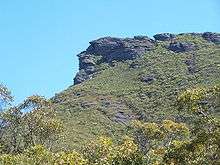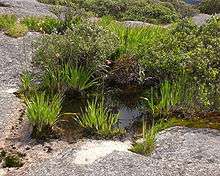Granite outcrops of Western Australia

Granite outcrops of Western Australia are inselbergs and monoliths made from granite that are found across much of Western Australia. Rising abruptly from the surrounding landscape they create a variety of microhabitats for plants, and provide seasonal resources and refuge for a range of animals. These areas thus have rich biodiversity and many endemic species. They are significant locations that tie in with the Aboriginal and European cultural heritage of Western Australia.
A number of animals are restricted to granite outcrops, including four species of reptile, the mygalomorph spider Teyl luculentus, and the larvae of the chironomid fly Archaeochlus. They are also an important habitat of rock-wallabies such as the black-flanked rock-wallaby, and Ctenophorus ornatus, the ornate crevice-dragon.
Pools of rainwater, known as gnammas,[1] often form on granite outcrops. These provide habitat to around 230 aquatic invertebrates, of which at least 50 are endemic to these pools,[2] and provide freshwater to other inhabitants and visitors.

The variable rock surfaces and soil types create niches for many plants. At least 1300 plant species occur on granite outcrops in Western Australia, many of which are endemic to these sites.
Great Southern region
Wheatbelt region
- Baladgie Rock
- Beringbooding Rock
- Boyagin Rock
- Bruce Rock
- Corrigin Rock
- Eaglestone Hill
- Elachbutting Rock[3]
- Gorge Rock 32°27′S 118°00′E / 32.450°S 118.000°E
- Hunts Soak
- Jilakin Rock 32°40′S 118°19′E / 32.667°S 118.317°E
- King Rock
- Kokerbin Rock also known as Kokerbin Hill 31°53′S 117°42′E / 31.883°S 117.700°E
- Wave Wall, Dog Rock, Devils Marbles
- Mount Walker 32°01′S 118°45′E / 32.017°S 118.750°E
- Anderson Reserve, Twine Reserve and Roe Dam
- Sandford Rocks
- The Humps
- Wave Rock
- Westonia Common
- Boodalim Soak
See also
Notes and references
- ↑ Main, Barbara (1 September 1997). "Granite outcrops: A collective ecosystem" (PDF). Journal of the Royal Society of Western Australia (80): 113–122. Retrieved 29 September 2008.
- ↑ Halse, Stuart (October 2000). "Small signs of a salty past" (PDF). ECOS. CSIRO (105). Retrieved 2007-01-07.
- ↑ Elachbutting Rock
- Bayly, I.A.E. Rock of ages : human use and natural history of Australian granites Nedlands, W.A.: Tuart House, 1999. ISBN 1-876268-29-8
- Granite Outcrops Symposium, 14–15 September 1996.p.87–237.Journal of the Royal Society of Western Australia,vol.80, pt.3 (September 1997)
Further reading
- (1999) Managing granite outcrops for Western Australia / produced by the Revegetation on Farms Project, AGWEST, with input from CALM and the Royal Society of Western Australia. Narrogin, W.A. : Agriculture Western Australia ("A Project of the Sustainable Rural Development Program of Agriculture Western Australia, contributing to the Western Australian Salinity Action Plan")
- Hopper, S.D., Brown, A.P. and Marchant, N.G. (1997) Plants of Western Australian granite outcrops, Journal of the Royal Society of Western Australia, vo.80:141–158
- Hussey, B. M. J.(1998) 'How to manage your granite outcrops' Como, W.A. : Dept. of Conservation and Land Management, ISBN 0-7307-1203-6 (pbk.)
- McMillan, Peter.(1990) Exploring granite outcrops written by Peter McMillan, illustrations by Margaret Pieroni, edited by Richard Grant and Carmel Staniland. Como, W.A: Dept. of Conservation and Land Management.
- Withers, P.C. and Edward D.H. (1997) Terrestrial fauna of granite outcrops in Western Australia, Journal of the Royal Society of Western Australia, vol.80:159–166
External links